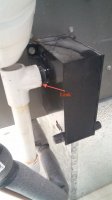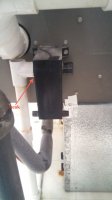Hello,
I have a Lennox G51MP Furnace. I recently noticed the condensate trap is leaking. I am pretty sure it is Lennox drain trap Cat # : 61M35 | Model/Part #: LB-96382A. The leak (just a slight but constant drip) is located where the pvc meets the trap's drain stub (at least that what I think it is called). See attached photos for the location of the leak.
I have tried pushing the pvc tighter to the trap but it still drips. I have tried separating the pvc from the trap but I can't (so I assume it has been glued). I have a few questions regarding the situation and how to fix it and am hoping you can provide me some much needed help!
1. Is it common practice to glue the pvc to the trap at the location of my leak?
2. Since I cannot seem to pull the pvc out, can I just apply some glue at the source of the leak to fix this?
3. If so, I have this Oatey PVC Cement on-hand. Is it okay to use?
Thank you for any and all assistance!
I have a Lennox G51MP Furnace. I recently noticed the condensate trap is leaking. I am pretty sure it is Lennox drain trap Cat # : 61M35 | Model/Part #: LB-96382A. The leak (just a slight but constant drip) is located where the pvc meets the trap's drain stub (at least that what I think it is called). See attached photos for the location of the leak.
I have tried pushing the pvc tighter to the trap but it still drips. I have tried separating the pvc from the trap but I can't (so I assume it has been glued). I have a few questions regarding the situation and how to fix it and am hoping you can provide me some much needed help!
1. Is it common practice to glue the pvc to the trap at the location of my leak?
2. Since I cannot seem to pull the pvc out, can I just apply some glue at the source of the leak to fix this?
3. If so, I have this Oatey PVC Cement on-hand. Is it okay to use?
Thank you for any and all assistance!


